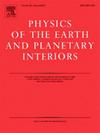Spectral characteristics and implications of located low-frequency marsquakes and impact events from InSight SEIS observations
IF 1.9
3区 地球科学
Q2 GEOCHEMISTRY & GEOPHYSICS
引用次数: 0
Abstract
The frequency characteristics of recorded ground motion are crucial to understanding seismic wavefield originating in marsquakes and interior structures of Mars, such as seismic velocity and discontinuities. Based on the frequency content, the Marsquake Service (MQS) categorized marsquakes into low-frequency (LF) and high-frequency (HF) families and further classified them into subcategories. For example, the LF family consists of two types: low frequency (LF; < 1 Hz) and broadband (BB; predominantly <2.4 Hz). Previous studies have presented the frequency characteristics of a few significant marsquakes. With the recent application of new techniques, more marsquakes with a quality high enough to be characterized as “QB” have been located. These newly located marsquakes have the potential to constrain the internal structure of Mars, but seven of them occurring during sols 0–1011 and their spectral characteristics have not been discussed yet. Here, we first summarize these seven LF-type, B-quality marsquakes: S0185a, S0325a, S0407a, S0409d, S0484b, S0916d, and S0918a following the standard procedures of Marsquake Service. Additionally, we examine the characteristics of the two largest impact events, S1000a and S1094b, classified as BB events. We determined the frequency bounds in the Butterworth bandpass filter of all A- and B-quality LF-family marsquakes and the two impact events. We found that most LF-family marsquakes have an upper bound frequency no larger than 1 Hz, except for S0235b, reaching 1.1 Hz. Moreover, the P- and S-wave arrivals of marsquakes present highly varied spectral behaviors based on the analysis of the spectral ratio between P and S waves. We finally discuss the implications of the highly varied spectrum and S-to-P spectral ratio for these marsquakes.

来自洞察号SEIS观测的低频地震和撞击事件的光谱特征和含义
地面运动记录的频率特征对于理解火星地震的地震波场和火星内部结构(如地震速度和不连续面)至关重要。MQS (Marsquake Service)根据频率内容将地震分为低频(LF)和高频(HF)两类,并进一步细分。例如,LF系列包括两种类型:低频(LF);& lt;1 Hz)和宽带(BB;主要为<;2.4 Hz)。以前的研究已经提出了一些重大地震的频率特征。近年来,随着新技术的应用,越来越多的高质量地震被定位为“QB”级地震。这些新发现的火星地震有可能限制火星的内部结构,但其中7次发生在sols 0-1011期间,它们的光谱特征尚未得到讨论。本文首先按照美国地震局的标准程序,对S0185a、S0325a、S0407a、S0409d、S0484b、S0916d、S0918a这7次f级、b级地震进行总结。此外,我们还研究了两个最大的撞击事件S1000a和S1094b的特征,它们被归类为BB事件。我们确定了所有A级和b级低频族地震以及两个撞击事件的巴特沃斯带通滤波器的频率边界。我们发现,除了S0235b外,大多数lf族地震的上限频率都不大于1 Hz,达到1.1 Hz。此外,基于P波和S波的频谱比分析,地震的P波和S波到达表现出高度变化的频谱行为。我们最后讨论了这些地震的高度变化的光谱和s - p光谱比的含义。
本文章由计算机程序翻译,如有差异,请以英文原文为准。
求助全文
约1分钟内获得全文
求助全文
来源期刊

Physics of the Earth and Planetary Interiors
地学天文-地球化学与地球物理
CiteScore
5.00
自引率
4.30%
发文量
78
审稿时长
18.5 weeks
期刊介绍:
Launched in 1968 to fill the need for an international journal in the field of planetary physics, geodesy and geophysics, Physics of the Earth and Planetary Interiors has now grown to become important reading matter for all geophysicists. It is the only journal to be entirely devoted to the physical and chemical processes of planetary interiors.
Original research papers, review articles, short communications and book reviews are all published on a regular basis; and from time to time special issues of the journal are devoted to the publication of the proceedings of symposia and congresses which the editors feel will be of particular interest to the reader.
 求助内容:
求助内容: 应助结果提醒方式:
应助结果提醒方式:


